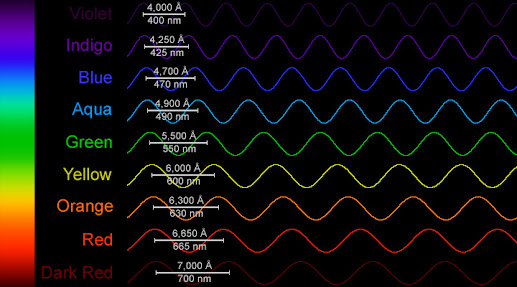The electromagnetic (EM) spectrum

The Sun emits radiation across most of the electromagnetic spectrum, from high-energy X-rays to ultra-long wavelength radio waves. Electromagnetic radiation from the Sun is the main source of energy that drives Earth's climate system.
Light comes in different colours, spread across the rainbow of hues that are called the visible spectrum. Each colour corresponds to waves with different wavelengths. Red waves are the longest, purple the shortest. Since all colours of light (and all types of EM waves, for that matter) travel at the same speed, the wavelength is inversely proportional to frequency (frequency is how often the "crest" of a wave passes by a given location). Long-wavelength red waves have low frequencies; short-wavelength purple waves have high frequencies. Different colours of light also carry differing amounts of energy. High frequency, short-wavelength purple light carries the most energy; low frequency, long-wavelength red light carries the least energy.

Visible light is but one small segment of the entire electromagnetic spectrum. Waves that have wavelengths slightly shorter than purple light, and thus have slightly higher frequencies and higher energy levels, are called ultraviolet ("beyond violet", from the Latin ultra = "beyond") or UV "light" or radiation. Humans cannot see UV "light", though some animals, like honeybees, can. Likewise, just beyond the other end of the visible spectrum lie waves with wavelengths slightly longer than red light waves. These waves, which have even lower frequencies and carry somewhat less energy than red light, are called infrared ("below red", from the Latin infra = "below") or IR "light" waves.
IR and UV and visible light are not the whole matter. Beyond the UV portion of the spectrum lie the still shorter waves (with higher frequencies and greater energies) of X-rays. Beyond X-rays lie the extremely short wavelength gamma rays, which have exceptionally high energies and frequencies. Moving in the other direction, out beyond the infrared portion of the EM spectrum, are various types of radio waves. All radio waves have longer wavelengths than infrared waves, and thus carry less energy and have lower frequencies. Microwaves are relatively short wavelength (and thus relatively high energy) radio waves.

The Sun emits EM radiation across most of the electromagnetic spectrum. Although it produces gamma rays as a result of the nuclear fusion process, these super high energy photons are converted to lower energy photons before they reach the Sun's surface and are emitted out into space. So the Sun does not give off any gamma rays to speak of. The Sun does, however, emit x-rays, UV, light, IR and even radio waves.
The peak of the Sun's energy output is actually in the visible light range and human eyes are tuned to the radiation that the star most abundantly emits. Each second the Sun converts about 600 million tons of hydrogen (8.9 ×1037 protons) into helium, releasing 3.83 x 1023 kilowatts of energy. The fusion process transforms 4.26 million tons of matter (equivalent to the mass of about 60 million people) per second into energy. How much energy is generated? It is the equivalent of exploding 90 billion megatons of TNT or roughly 10 billion hydrogen bombs. In less formidable terms, if all of the Sun's energy output for one second could somehow be captured, it would supply Earth's energy needs (at the current rate of use) for 500,000 years.
The core is the only place in the Sun where this nuclear fusion process occurs. The incredibly energetic photons immediately begin working their way outwards towards the Sun's surface. Given the radius of the Sun (696 thousand km) and the speed of light (almost 300 thousand km/sec), one might think that these photons reach the surface of the Sun in a matter of seconds. In actuality, scientists estimate that energy's trip from the core to the photosphere takes somewhere between 17 thousand and 50 million years! How can this be? Because the density at the Sun's core is so incredibly high, an average photon travels less than one millimetre before colliding with some matter. Since photons must undergo so many collisions (some of which deflect them back in the direction from which they came!) during their outward journey, their path to the surface is anything but straight. This ultra-zigzag path often referred to as a random walk significantly delays the flow of energy from a star's core to its surface.
No comments:
Post a Comment